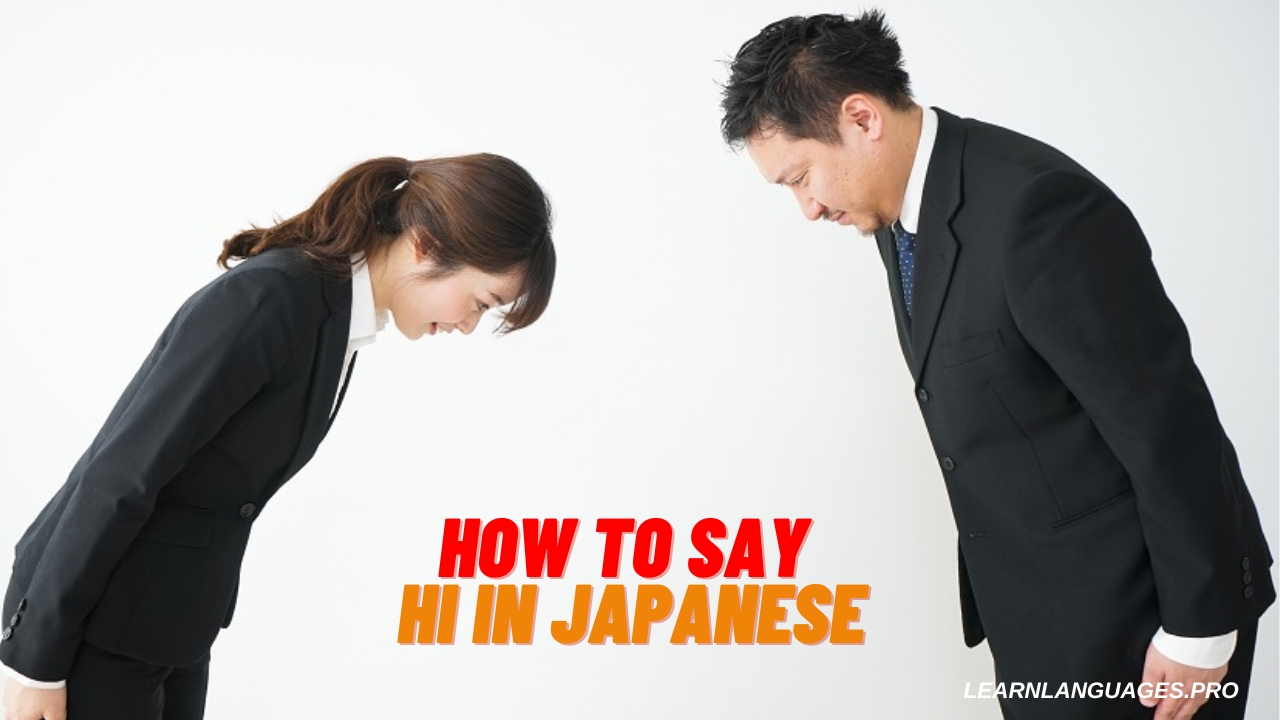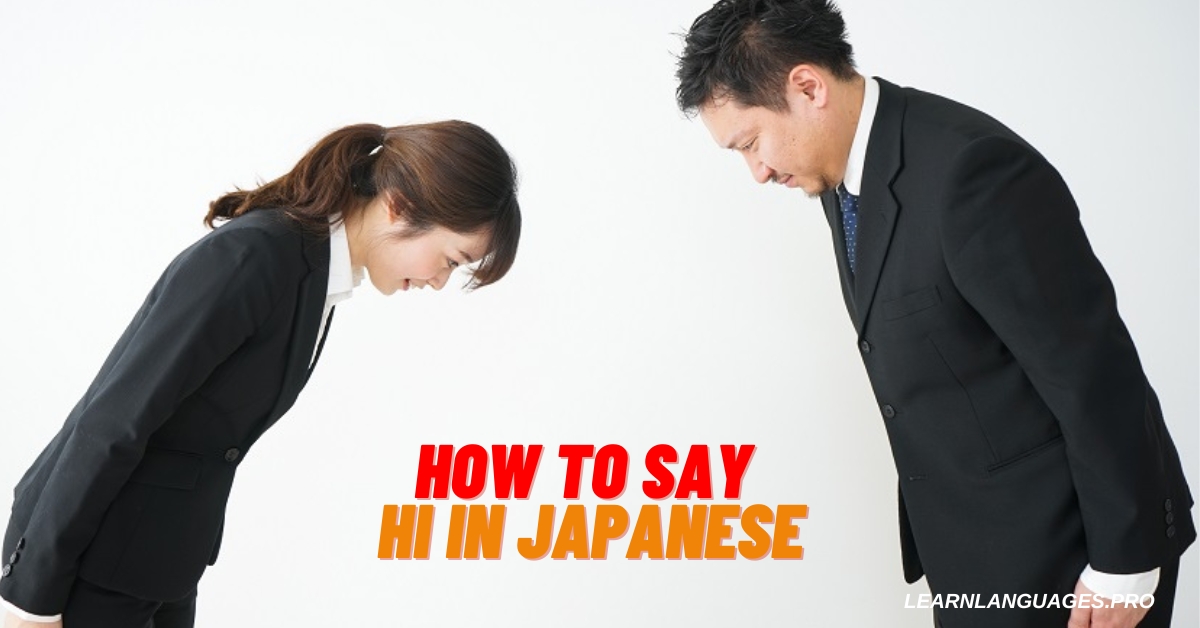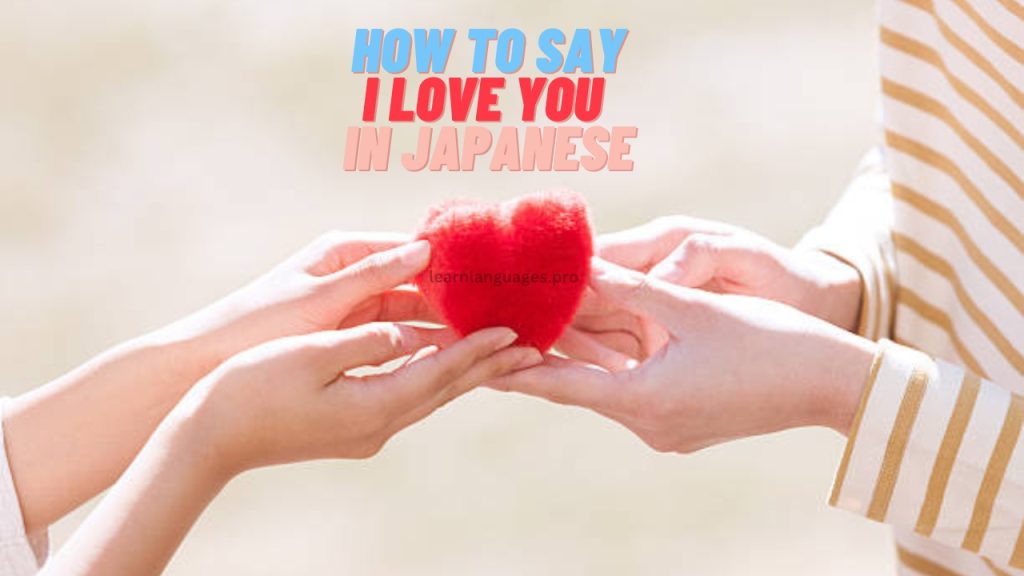Hi in Japanese
How to say hi in Japanese when with friends, greetings can be more casual:
やあ (Yaa): Like “Hi” or “Hey,” it’s pretty in a casual tone.
おっす (Ossu): A complimentary greeting mainly used among teenage boys or close friends.
はよう!(ohayou): It is a short form of おはよう ohayou, which means good morning in Japanese.

Different greetings according to the time of day
The standard greetings change with the time of day in the Japanese language:
おはよう (Ohayou): It is the methoed of saying hi in japanese mostly used in the morning. If you need to speak in a more formal context to someone, you can say おはようございます (Ohayou gozaimasu).
こんにちは (Konnichiwa): It is used from late morning to early evening, i.e., from approximately 11 AM to 5 PM.
こんばんは (Konbanwa): Literally, it is the other way of hi in Japanese , it means good evening. Like Konnichiwa, it’s already formal enough as a catch-all phrase for greeting people in the late afternoon or evening.
Uniquely contextual of how to say hi in Japanese greetings
Hello: When answering the phone call
Irasshaimase: welcome, usually said by the restaurant or shop when welcoming customers.
Hisashiburi: It’s been a while. It is generally said to friends or acquaintances but has not been seen for some time.
Practice the terms “Hi” and “Hello” in Japanese.
These approaches will make you more comfortable speaking in Japanese. How about using these tips?
Listen and repeat: Listen to speakers using those greetings in context (via movies, shows, or language apps), and repeat after them.
Put it in real life: If you do have collections of Japanese friends or know someone speaking the language, try greeting them using those phrases so you can train yourself to talk like say them naturally.
Language exchange: Language exchange programs come handy for practicing such phrases as there are hardly any restrictions in sharing two different languages for learning.
Hello, in other Japanese languages

In accompanying phrases or word greetings, manythere are other phrases through which Japanese can be expressed a little more than a few. Here are some examples:
こんにちは、調子はどうですか? (Konnichiwa, choushi wa dou desu ka?): “Hello, how are you?” indicates a way to open up a polite conversation and inquire about the other person’s well-being.
やっほー、久しぶり! (Yahhoo, hisashiburi!): “Hello, long time no see!” This is the greeting for friends whom you haven’t seen for a long time.
お疲れ様です (Otsukaresama desu): “Thank you for your work” is one of the most common greetings after a day’s work in Japanese: it recognizes the hard work of your coworkers and greets them at the end of busy days.
元気? (Genki?): This is a casual, friendly way to ask someone how they are doing, mainly used between close friends.
ハロー (Haro): Hello (informal): This is a casual greeting unsolicited borrowed from English, very popular in Japan, especially among younger people or all the time.
ヤッホー (Yaahoo): This expression is another informal greeting that has a playful or cheerful tone and is especially common between friends and in lighthearted situations.
おつかれさまです – (Otsukare sama desu): The value of the hard work done is appreciated. It is often exchanged at the end of work hours or when a project has been completed. The phrase can also be an informal way to show gratitude towards friends for the hard work done together.
It is a great first step for one to familiarize himself with Japanese speakers. Go to further enrich his understanding of the language culture by learning and making use of these greetings. So start practicing today, and before you know it, you’ll feel much more comfortable using expressions you once had trouble with!
FAQs
What does konnichiwa mean in Japanese?
Japanese greeting and salutations differ according to time of the day as well as the level of formality that goes with it. They include ‘おはようございます,’ meaning ‘good morning; ‘こんにちは,’ meaning ‘good afternoon; ‘and ‘こんばんは,’ which means ‘good evening.’ For each case, there is an act of acknowledging another person along with a show of context-appropriate respect towards that person.
Is it polite to say konnichiwa?
Yes, “こんにちは” (Konnichiwa) is generally considered a polite way to say hi in Japanese and is known to mean ‘Good afternoon’ or ‘Hello’ throughout the day. It can be used in most social situations where respect is understood. For more formal encounters, especially in regard to business or someone of higher status, using more formal greetings or phrases should be observed.
Most politest, gracious way of greeting in Japanese?
The most formal and polite method of saying hi in Japanese. Which depends upon the time of the day and the situation itself. In context to meeting someone for the first time. “初めまして” (Hajimemashite) would be more likely used to show formality in respect at any time in the day. It means “Nice to meet you.” Besides that, “お世話になっております” (osewa na tteimasu) is a very polite word to say hello. Especially if you have an ongoing conversation with someone in a professional setting.
Are you aware of how a person says Hi in Japanese?
Now, to say hi in japanese, one would say “こんにちは” (Konnichiwa) in the Japanese language. It is somewhat a general expression concerning greetings during the daytime. But in case someone wishes to type Hi to someone else super-casually or someone uses it for informal “Hi” only among themselves. He can use either “やあ” (Yaa) or “やっほー” (Yahhoo) although those are not used much outside friends. Even the single Konnichiwa suffices for extremely casual meetings.



What an intriguing article! The website’s seamless navigation made it even more
enjoyable to explore.